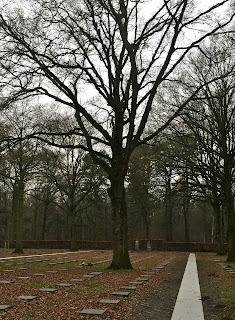Battle of the Yser - late 1914
I hadn't fully appreciated that a small north corner of Belgium remained unoccupied by Germany throughout the war, on account of the Battle of the Yser; and that from here, based in the small town of De Panne, King Albert led his country's defence throughout that time. The Belgian Government meanwhile was evacuated to safety in Le Havre. Small wonder that the grateful nation erected this large memorial to him at Nieuwpoort, a hero on horseback.
Even more fascinating, the Goose Foot system of sluices (you can see why so named, below) at the same site that made this possible. At the northern limits of the race to the sea - when it looked likely that the advancing Germans would break along the coast and threaten Dunkerk, Calais and Boulogne - the order given to open these sluices flooded the plains around the Yser as far south as the existing northern limit of the front at Dijksmuide, and stopped any further advance.
On the left, a gloomy December day's view of one of the sluices.
Below an aerial view and diagram of the brilliant Belgian engineering system that in peacetime had reclaimed land behind the dykes. Under constant shelling from the Germans, they somehow managed to retain this barrier throughout four very soggy and difficult years
Vladslo Cemetery
 |
| Kathe Kollwitz, a remarkable German sculptor, symbolised the grief felt by all bereaved families in this famous sculpture. |
 |
| The Grieving Parents, a memorial to Kollwitz's son Peter, can be seen at the far end of the cemetery. Peter is buried just in front of the father |
Vladslo is one of four German mass cemeteries in Belgium, consolidated from numerous smaller ones. This was my first visit here, though I have been several times to Langemarck, outside Ypres. They have a very different feel to the British and French sites, but are equally moving.
Dijksmuide
A fascinating exhibition created for the WW1 centenary
occupies floors 21 down to 3 of this large
structure. The tower was built nearly 70 years ago to replace the original WW1 memorial, which was sabotaged at the end of WW2. Not by the Germans, as it turns out, but by the opponents of Flemish nationalism, which was a source of glorious resistance in 1914-18 but had grown close to fascism by the 1930s. Many of them were suspected or accused of fighting with the Germans in WW2. In recent years it has become symbolic of the peace movements, but still retains the Flemish insignia AVV-VVK ("All for Flanders - Flanders for Christ")
The white lettering at the base reads "No more war" in four languages.
Second Battle of Ypres
Squelching evocatively through the muddy roads and fields around Ypres I revisited some touching reminders of the heavy fighting the followed the german gas attack at Ypres 2. The battle of St. Julien was a desperate phase to hold on after the initial ground losses brought about by the gas. The Seaforth Highlanders lost heavily in this battle and the Seaforth Cemetery on the site of a farm based redoubt nicknamed Cheddar Villa looks out over bleak landscape, with slopes of Passchendaale in the distance.
Other heroic actions were fought, especially by the Canadians between the Poelkappe and Konnebecke roads. At the crossroads named Vancouver Corner is the famous memorial of the Brooding Soldier. He is looking downwards and in the direction from which came the poison gas cloud on the evening of 22nd April 1915.
Battle of Loos
 |
| Sir Herbert Baker's amazing Loos Memorial. It resembles his largest at Tyne Cot, and carries the names of over 20,000 British lost at Loos and other battles in the area. |
After crossing into France through Mesen and Armentieres, I looked at sites around Aubers Ridge, Neuve-Chappele and Festubert - where early spring actions took place in 1915 - before moving further south to Loos. Loos was the British contribution to Joffre's second major attempt of 1915 to break through German positions in Champagne and Artois. Loos was at the northern end of the assault and was part of the effort to break the Lens salient and cut German communications with their forces further south, especially in Champagne.
It was, as we know (Battle of Loos, 6/10/15 post), a costly failure right along the front. The valiant British troops were able to take the first lines of defence, following up a huge preceding bombardment, but were to discover the extent to which the Germans had consolidated deeply, with second and subsequent lines of defence mauling the attackers. The British reserve forces were badly managed by Sir John French, and he paid for this with his job by the end of the year.
The battle was carried on through the industrial heartland of north east France and the coal mining slag heaps are still very much in evidence. The Loos Memorial stand right by the main road north of Loos-en-Gohelle and traffic thunders by as you look over the scene.
In Loos itself is a beautiful small cemetery, St. Patrick's, with mostly Irish headstones but, unusually, also some French graves and one German. The cherry trees were in blossom in mid-December!















